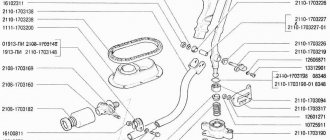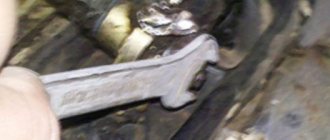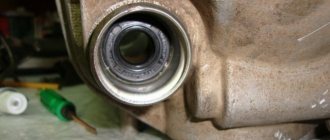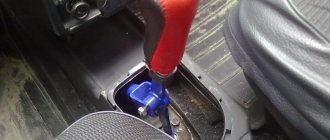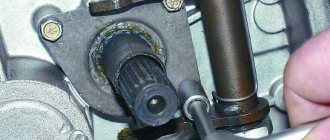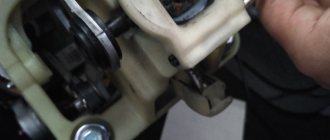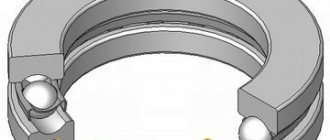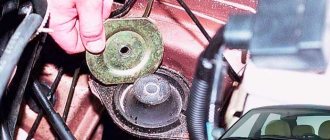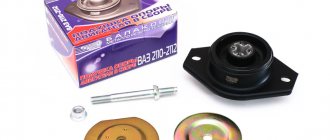VAZ 2110 gearbox locks
- Registration
- Entrance
- To the beginning of the forum
- Forum Rules
- Old design
- FAQ
- Search
- Users
vek
I don't know what you have, first of all adjust the backstage! If that doesn't help, disassemble the gearbox. And so go to SEARCH, there are tons of similar ones!
PS only knocks out the first one? or the back one?
Most likely the synchronizer is worn out.
“Sometimes it’s better to chew than to talk. "(c) I’ve never understood people who are “off topic” but consider it their duty to blurt out something. Well, what does the synchronizer have to do with it?
On this topic. — adjusting the rocker — look at the engine mounts (maybe it’s hanging around too much in the engine compartment and knocking out the gear?) — checking the presence of the locking ball and the integrity of the first gear locking spring (have you by any chance changed the oil in the gearbox? Otherwise there are “craftsmen” who replace the plug drain, unscrew the locking plug)
“Sometimes it’s better to chew than to talk. "(c) I’ve never understood people who are “off topic” but consider it their duty to blurt out something. Well, what does the synchronizer have to do with it?
Despite the fact that I had a similar problem. Maybe I didn’t call it the synchronizer correctly, or something else, but it’s a gear with a spring-loaded base. At the service center they removed the box and disassembled it, and then they showed me this gear with strong metal wear. Sorry for interfering with your intellectual conversation.
Despite the fact that I had a similar problem. Maybe I didn’t call it the synchronizer correctly, or something else, but it’s a gear with a spring-loaded base. At the service center they removed the box and disassembled it, and then they showed me this gear with strong metal wear.
A synchronizer is a device designed to equalize the rotation speeds of the primary and secondary shafts at the moment of gear shifting. It cannot have any influence on the “knocking out” of the transmission. We are probably talking about the 1st-2nd gear clutch? Then yes, it's possible. But coupling wear means runs > 200 thousand km. Or a long drive with a “crispy” second one. I guess vek
The mileage is still less.
Sorry for interfering with your intellectual conversation.
Despite the fact that I had a similar problem. Maybe I didn’t call it the synchronizer correctly, or something else, but it’s a gear with a spring-loaded base. At the service center they removed the box and disassembled it, and then they showed me this gear with strong metal wear.
A synchronizer is a device designed to equalize the rotation speeds of the primary and secondary shafts at the moment of gear shifting. It cannot have any influence on the “knocking out” of the transmission. We are probably talking about the 1st-2nd gear clutch? Then yes, it's possible. But coupling wear means runs > 200 thousand km. Or a long drive with a “crispy” second one. I guess vek
The mileage is still less.
Sorry for interfering with your intellectual conversation.
The wear of the coupling is not necessarily mileage > 200 thousand km. An unadjusted clutch or its constant under-pressure is enough, that’s the clutch and the tire. When the clutch wears out, the transmission begins to fall out (even without force on the gearshift knob), and then as it wears out, the transmission simply begins to knock out (even if you hold the clutch with your hand). The gear may also fall out due to wear on the rods of the gearbox forks (on the recesses for the ball). In general, first check the engine mounts (although on the 2110 the rocker is attached with a second lever directly to the engine, unlike the 08-099 design, which virtually eliminates the pederaci falling out when moving the engine), the presence and functionality of the transmission rod lock.
Reverse speed of automatic transmission does not engage
In practice, reverse gear may not be engaged in both manual and automatic transmissions. Taking into account the fact that automatic transmissions are different, it should be noted that some problems of manual transmission robots are similar to “mechanics”, while “classic” automatic transmissions have their own list of problems due to which the reverse speed disappears.
- The level of the ATF transmission fluid has deviated from the norm, the fluid in the automatic transmission is contaminated or has lost its properties. As you know, an automatic transmission is extremely sensitive to the level and quality of oil. For this reason, the check should begin with the transmission fluid.
Please note that both under and over levels can cause gears to shift incorrectly. Also, ATF oil has a limited service life, that is, the fluid needs to be changed every 40-60 thousand km, contamination, cloudiness, etc. are not allowed.
- Wear of automatic transmission clutches (friction discs). This malfunction often affects both reverse gear R and gears in drive mode D. Problems with clutches lead to gears not being engaged, and certain speeds may disappear (for example, the car goes to 1 and 2, but not 3 and 4, as well as reverse gear). To fix the problem, you will need to replace the automatic transmission clutches.
- Other automatic transmission malfunctions and breakdowns. For example, if the splines of the drive drum are cut off, the machine can move forward, but there is no reverse gear. There may also be complete absence of movement both forward and backward. To solve the problem, the drum needs to be replaced.
Other problems include broken brake band piston cuffs or severe wear. The malfunction only appears when the driver engages reverse gear, that is, the car moves forward normally, but there is no reverse movement. Another common problem with similar symptoms is failure or jamming of valve body valves and individual solenoids.
Additionally, experts draw attention to the fact that if there is no connection between the oil pump drive gear and the torque converter, the automatic transmission will not engage in both forward and reverse gears.
Features of fastening the VAZ 2110 gearbox
Box vaz 2110
One of the most obvious problems that require an immediate solution is replacing the gearbox in a VAZ 2110. And naturally, in the process you have to deal with such a component as mounting the VAZ 2110 gearbox. On the VAZ 2110, the gearbox mount has some features that make removing it from the car very problematic. To perform this work, you must have an assistant who will help in this difficult task. In addition to dismantling and disassembling the gearbox, it is also necessary to reassemble it. The assembly process is no less problematic.
Common gearbox problems
Owners of the VAZ 2110 car note several characteristic faults in gearboxes for this model. Some people do not engage reverse gear, others complain about overshoot, and so on.
Let's look at the most popular problems that the domestic "ten" box can boast of.
- First speed problem. It may fly out or be difficult to turn on in the car. There are several reasons:
- The synchronizer has failed;
- The latch spring has a defect, it has burst;
- The lever has become loose, causing the gears to switch spontaneously;
- The rod is out of order or the fork is faulty; they must be replaced.
- Second gear problem. It often gets knocked out, or it’s difficult to switch to it. There may also be several reasons for such a malfunction:
- The gear teeth do not cling well to the gear shift clutch;
- The tips of the teeth are worn out and worn out, making it difficult to switch on the speed. Over time it will begin to fly out. Therefore, repairs are required;
- If the gear is knocked out when hitting a bump, then there is nothing good about it - the problem lies in a failing clutch.
Having experience, relevant knowledge and skills makes it possible to deal with checkpoint problems with your own hands. If all this is missing, we strongly recommend that you contact a trusted service center, where they will carry out diagnostics, determine the true causes of the problem and return your gearbox to its previous condition. Yes, it will cost some money, but you can’t do without it. Nothing is eternal. Moreover, the “tens” gearbox.
OFFICE OPENING HOURS:
Mon-Fri: from 10:00 to 18:00 (Moscow time) Sat: coordinate your visit with the aircraft : closed
ACCEPTING ORDERS ON THE SITE: around the clock, 7 days a week, on weekends and holidays.
Sequence of actions when replacing the box
VAZ 2110 box mount
The sequence of actions should be as follows:
- The battery is removed from the vehicle.
- The process of draining the oil from the gearbox is taking place.
- The starter is disconnected.
- The clutch drive cable is dismantled.
Note: the cable is connected to the clutch release fork. The cable is located in a bracket on the box. To remove it, you need to pull it out of the socket.
- The speed sensor is connected to a block with wires. The pad can be detached by compressing the springs.
- The device has a bolt that connects the ignition module bracket and the gearbox. It must be removed. There are two bolts at the top of the transmission and engine connection. This is the VAZ 2110 gearbox fastener.
Note: The front bolt (which is located in the car along its direction) is shorter than the subsequent bolt.
- The rear light switch is connected to a block with wires. The block with wires is disconnected from the bottom of the car.
- The bolts securing the torque rod to the gearbox are unscrewed. There are two of them.
Fastening the VAZ 2110 box
Note. It should be noted that the reaction rod has contact with the gear selection rod hinge. By unscrewing the fastener, the clamp is loosened. For the convenience of subsequent actions, the rod moves to the side.
- The next step is to remove the wheel drive.
Note: There are two drives here. They can be roughly divided into right and left. A plug must be inserted into the right drive. It must be firmly secured, as it can slip out at the most inopportune moment. The drive, located on the left side, does not need to be completely removed. It is enough to move it a little to the side, in such a way that it does not interfere with subsequent actions.
- Unscrew two bolts on the left ball joint and steering knuckle. They are subsequently removed.
- In the lower right part, where the VAZ 2110 gearbox is attached to the body with a nut, it must be unscrewed to the side.
Note: Some vehicles that use a fuel injection system have a special intake pipe bracket under this nut. It must be removed and the pin left.
- The fastening nut may be loosened if some elements are in the way.
Fastening the box with the rocker of the VAZ 2110
- The clutch housing has three bolts on the bottom cover that hold it in place. They must be removed and the cover removed.
- There is a bolt in the left corner of the gearbox mounting to the engine. It must be unscrewed and set aside.
- Move the engine up a little.
Adjusting the gear shift lever and drive
All that remains is to adjust the gear shift lever and clutch release drive. To do this, you also need to know a few simple rules. To check the gear shift lever:
- The transmission control rod has a clamp nut. It is necessary to unscrew the bolt quite a bit.
Note: Access to the nut is from underneath the vehicle.
- It is necessary to have access to the free movement of the gear selection rod. After some operations to increase the connector, it is necessary to put the rod in the neutral position.
- The subsequent operation takes place inside the car. The gearbox cover is removed from the lever. It is enough to move it down.
- In the opened space, you need to find the reverse locking bracket.
- The lever must be fixed in the position where the groove of the lever axis stop is pressed against the template.
Note: it is necessary to carry out the shift smoothly and carefully, since the bracket itself can be deformed.
- From the bottom of the car, the rod play is placed in the “backward” position. The angular play must be placed counterclockwise.
- The nut of the clamp block under the car is tightened. The clamp needs to be moved forward a little. A space of 2-3 millimeters is provided.
The clutch pedal is adjusted in the following way:
- The car is installed on a flat surface. The minus terminal must be disconnected from the battery.
- A ruler is placed on the floor near the pedal. The measurement is taken from the floor to the rubber pad. If the indicator exceeds 160 millimeters, the pedal should be adjusted.
- When the hood is open, there is a metal clutch cable that should already be disconnected. Adjustment occurs by turning the nut. By tightening the nut, the gap decreases. Unscrewing the nut increases the pedal travel.
- Press the clutch pedal several times. If the results change, it is necessary to adjust the nut again.
- The rubber limiting sleeve moves into the fork to the limit.
Gearbox VAZ 2110
Like any car, the VAZ 2110 is equipped with a gearbox. In the case of the designated model, this mechanism has 5 stages and is controlled via a shift lever, which, in turn, is located inside the car.
To ensure that there are no problems with the operation of your VAZ 2110, and that you can correct all kinds of failures yourself, you will need to understand the principles of operation and the design of the gearbox. We will also consider the process of changing the oil for the “ten”.
Automatic transmission for VAZ 2110 or V-belt version
Automatic transmission for VAZ 2110
A very common statement from modern drivers of VAZ 2110 cars is the presence of an automatic transmission. This topic is becoming so relevant that it requires explanation. It becomes easier for drivers of these cars to install a similar system on their own car. Already in the mid-twentieth century, cars with automatic transmissions began to delight their owners. Although, this system remained unattainable for domestic cars. Enthusiasts from AvtoVAZ managed to moderate the ardor of drivers with their statement. They issued an order for the construction of this system to the Moscow Center for Automatic Transmissions (MAI). The German company, one of the world experts in this technology, ZF, took an active part in the development. This system was immediately installed on the 10th VAZ model, but the automatic transmission was not actually such. It was replaced by a V-belt version. As studies have shown, a car whose engine does not reach a volume of 2 liters practically cannot use this system. There are several reasons for this:
- The placement of the engine reduces the installation of an automatic transmission to a minimum.
- This system turned out to be too expensive to maintain.
- Since the VAZ 2110 car does not have sufficient power and torque, changing gears with automatic transmission is not always possible.
V-belt version of the box - what is it?
VAZ 2110 automatic transmission V-belt version
That is why it was decided to use the V-belt version. This option allows you to create the necessary and sufficiently strong torque. The composition of the device is very simple:
- Two sliding pulleys.
- The belt that connects them.
Depending on the movement of the pulleys, the gears are switched:
- At the moment of compression of the driven pulley, we get a “low” gear.
- The middle position of the pulley makes “direct” transmission possible.
- Increasing the diameter of the drive pulley makes it possible to obtain an “overdrive” gear.
The configuration of the equipment implies, at the time of acceleration, obtaining a constant number of engine revolutions. The power indicator increases to the maximum number. Speed switching is carried out by a smooth, stepless change in the gear ratio. Such indicators allow the car to achieve improved acceleration. The braking process using an automatic transmission is also different. At the moment of sudden braking on a slippery road, a skid may occur.
A car with an automatic transmission has several features. When the gas pedal is released, the car perceives this signal as a transition to a higher gear. This reduces engine braking to a minimum, and more often than not, no braking occurs at all. To perform this action, you must use a special mode. Although while driving, such switching will not help much, but engine braking will still occur.
Gearbox VAZ 2110
The design of the gearbox is as follows: to ensure switching, the gearbox contains a so-called input shaft, which consists of a special block and gears. They are located in such a way that they are in constant mesh with the drive gears from speeds 1 to 5 (those that allow you to move forward). There is also another secondary shaft on which the main gear drive gear and synchronizers are located, which ensure forward movement. In addition, bearings and the so-called oil sump are located here.
The VAZ 2110 device assumes the presence of a two-satellite type differential. The drive part of the gearbox consists of a shift knob, a ball joint, a rod, a rod and mechanisms for selecting gears. The presence of jet thrust is explained by this - this is a measure to protect the gearbox from so-called “overshoots”. This traction is fixed with a support and a power unit.
How to repair a gearbox on a VAZ 2110
Adjustment does not always achieve the desired effect. Therefore, the motorist will need to carry out repair work. Practice shows that repairing a VAZ 2110 gearbox involves dismantling and reassembling the gearbox. Now I will tell you in detail how to do this.
How to remove/dismantle a VAZ 2110 box
How to remove the box? Before disassembling the gearbox, it must be cleaned
It is important that water does not get inside the box.
Main stages:
- Power from the battery is turned off.
- The block is disconnected from the speed sensor.
- Transmission fluid is drained.
- The bolts securing the jet thrust are removed.
- It is necessary to remove the constant velocity joints from their standard location.
- The existing ball joint bolts are loosened.
- Using a tool, unscrew the nuts holding the clutch cover to the gearbox housing.
- The bolts securing the gearbox to the engine are disconnected.
- The power plant must be lifted (use a jack).
- The engine mounts must be removed.
- To pick up the gearbox, you can use a screwdriver.
- The speed box slides off the guides. The input shaft should disengage from the clutch.
How to properly disassemble a VAZ 2110 gearbox
- We remove dirt and wash the outside of the gearbox (do not allow water to enter the crankcase).
- Using a 17mm wrench, unscrew the bolt securing the power unit suspension bracket.
- Using a 13mm socket, unscrew the six nuts securing the rear crankcase cover.
- Remove the bracket.
- Tapping with a copper hammer (or an ordinary one through a soft metal mandrel) on the tides of the lid, and remove it along with the sealing gasket from the studs.
- Having pressed the gear selection rod all the way, we turn on the third gear, or, by retracting the rod all the way, we turn on the fourth.
- Using a 10mm spanner, unscrew the bolt securing the fifth gear fork.
- Using a soft metal drift, we strike the fork downwards, including the fifth gear of the VAZ 2110
- Use a beard to straighten dents in the nuts of the primary and secondary shafts
- Using a 32" socket with a powerful wrench, unscrew the shaft nuts.
- Using a screwdriver, pry off the fifth gear fork and remove the fifth gear assembly. Remove the fifth gear shift fork.
- Remove the synchronizer sliding clutch from the hub. Remove the synchronizer blocking ring. We take out the thrust plate.
- We move the hub inside the sliding clutch of the Synchronizer and remove the hub, springs, clamps and crackers of the fifth gear synchronizer.
- Using a copper hammer we strike the end of the input shaft. Insert two screwdrivers into the resulting gap between the thrust plate and the fifth gear drive gear. Prying up the gear with screwdrivers, we press it
- Using the “13” socket, unscrew the three plugs of the gearshift rod clamps. Remove the springs and retaining balls from their sockets.
- Using a Phillips impact screwdriver, unscrew the four screws securing the thrust plate. The screws have special lock washers.
- Remove the thrust plate. Use two screwdrivers to pry off the thrust washer of the fifth gear driven gear bushing. We insert the puller arms into the resulting gap between the end of the rear bearing and the thrust washer and compress the gear sleeve and the thrust washer.
- Use two screwdrivers to separate the retaining ring on the input shaft and remove it. In the same way, remove the retaining ring from the secondary shaft.
- We insert a screwdriver into the socket of the latch and, applying a magnet to it, remove the ball.
- Using a “13” socket, unscrew thirteen nuts and one bolt securing the gearbox housing to the clutch housing.
- By inserting a screwdriver into the groove at the junction of the crankcase mating planes, carefully lift the box crankcase and remove it.
- Using a 10mm spanner, unscrew the bolt securing the 1st-2nd gear shift fork to the rod. We lift the rod up and disengage the fork. Using a 10mm spanner, unscrew the bolt securing the 3rd-4th gear shift fork to the rod. Use a screwdriver to remove the rod from the gear selection mechanism.
- Raise the rod up and remove the fork from the groove of the synchronizer sliding clutch.
- By turning the 5th gear engagement rod, we remove it from the gear selection mechanism. We take out the axis of the reverse intermediate gear.
- Remove the reverse intermediate gear. We simultaneously remove the primary and secondary shafts from the roller bearings of the clutch housing.
- We take out the differential assembly. The process of repairing a VAZ 2110 gearbox
- Using a 10mm socket, unscrew the three bolts securing the gear selection mechanism and remove it.
- Using a 10mm socket, unscrew the installation bolt of the gear selector lever. Remove the gear selector lever from the rod.
- Using a screwdriver, remove the protective cover of the rod from the bushing. We take out the gear selection rod.
Adjustment work with the VAZ 2110 gearbox
Many of the owners of the VAZ 2110 mention cases when shifting gears is difficult, they are difficult to engage, and there are also frequent cases when these same gears are simply knocked out. Manufacturers have made sure that for such cases there is a special adjustment mechanism for the drive to select the speed.
This mechanism will be very useful when:
- The gearbox has been removed or was previously removed for repair work.
- One of the gears fails.
- Shifting gears occurs with effort, is difficult, or they simply get knocked out while the car is moving.
Provided that one of the described problems is typical and present in your VAZ 2110, you will need to make adjustments. It consists of the following steps:
- On the bottom of your car you will need to find the nut of the bolt that tightens the clamp that secures the rod required to carry out the gearbox control process. The nut will need to be loosened.
- Next, you need to move apart the grooves at the end of the rod using a screwdriver and also the crack on the clamp. Such manipulation will be required so that the rod can easily move relative to the gear selection rod. Set the rod itself to the neutral position.
- The shift knob must be freed from the cover.
- The lever is set according to a special pattern. In the rear speed locking bracket adjustment window, a template is set. Next, a stop for the lever axis is inserted in place of the template groove, and it is necessary to press without unnecessary effort in the transverse direction.
- Next, the axial play of the rod is adjusted in the rearward direction.
- The clamp is fixed a few millimeters from the end of the rod. Next, tighten the same clamp with a bolt.
Repairing the box
In the case where this kind of adjustment work did not bring much results, you will have to remove and disassemble the gearbox of your VAZ 2110. The main attention should be paid to the gears, since they are most often knocked out. This is especially true for first and second speeds. It will also be important to check the latch.
There are three latches in total in the gearbox. The very first of them is very long and is responsible for 1st and 2nd gears. Next comes the clamp for third and fourth gears, and the shortest of the clamps is intended for 5th gear.
complete gearbox assembly
Reverse gear of VAZ 2109 does not engage: causes and repairs
The situation when reverse gear does not engage on a VAZ 2109 is one of the most common problems with this car model. In addition, the VAZ 2108/09/099 “Samara” and VAZ 2113/14/15 “Samara-2” cars were equipped with the same type of gearbox (gearbox), so this transmission malfunction is typical not only for “Nines”.
Often, an attempt to engage a gear is accompanied by a strong crunch of gears, and if the gear is able to be engaged, the gearbox makes noise when moving in reverse. Other owners are faced with a situation where the gear shift lever moves forward all the way, but reverse gear does not work. At the same time, there are no complaints about shifting forward gears.
Problems
Often, VAZ 2110 owners voice a problem regarding the switching or departure of first gear. Most likely, the reasons lie in the following:
- synchronizer problems;
- damage to the retainer spring when the lever dangles and the gears are switched on randomly;
- damaged rod and fork.
A common problem is when the second gear is reluctantly engaged, or it is simply knocked out. The most likely causes of the problem:
- poor engagement of the gear and clutch that engages the gears;
- wear of gear teeth and coupling;
- problems with the clutch.
Transmission repair
Adjustment does not always achieve the desired effect. Therefore, the motorist will need to carry out repair work. Practice shows that most often the gears that are responsible for the first and second speeds are knocked out. When disassembling, the car owner needs to make sure that all fasteners are in good condition. We are talking about 3 springs. 1 design serves the first and second speeds, 2 - the third and fourth, and 3 - the fifth. The first clamp has the maximum length.
Before repairing a VAZ 2110 gearbox with your own hands, it is recommended that you carefully study the video material, as well as read the operating manual.
Let's look at the most common faults that occur in the 10th model gearbox. In fact, there are quite a lot of problems with the VAZ-2110 gearbox. First gear often doesn’t engage well (or crashes out) main reasons:
- synchronizer wear;
- latch damage. Most often the spring breaks;
- The lever is not locked. This leads to spontaneous gear shifting;
- the rod has become unusable;
- The gearbox fork is damaged.
Changing the oil
According to the documentation, the lubricant component in VAZ 2110 engines and transmissions must be changed every 15 thousand kilometers or at least once a year.
So, we need to warm up the engine well and prepare the required oil and, preferably, a new oil filter, as well as the tools necessary for the job.
gearbox housing 2110
To drain the waste, you will need to unscrew the plug from the oil pan. Next, within 10-15 minutes, the oil is drained into a special container, which will need to be prepared in advance. Then the drain plug returns to its original position and is screwed tightly. Now you can replace the old oil filter with a new one (if necessary).
Now that the old oil has been drained, pay attention to its color and presence of inclusions. If the oil is dark brown in color and to the touch contains various types of inclusions such as metal dust or pieces of dirt, then the transmission will need to be flushed.
Operating principle and troubleshooting of the VAZ 2110 gear shift mechanism
Like any car, the VAZ 2110 also has a gear shift mechanism. The VAZ gearbox is five-speed, activated by a lever located in the car's interior.
In order to be able to fix problems yourself, you need to understand a little about how exactly the switching mechanism works, which is why there are cases when some speed does not turn on or goes out. And also know how to fix it on your own.
Repair kit for VAZ 2110 gearbox 4th gear (up to 10.2000) Buy at a price of 1429 rub.
Dear customers, in order to avoid errors when sending a set of 4th gear gears for a VAZ 2110 gearbox, please indicate your car model, year of manufacture, and month in the “Comment” line.
Any car of the VAZ family has a gear shift mechanism, which consists of a gear shift lever, a ball joint, a rod, a gear selection rod and a gearbox.
The gearbox is designed to change the torque developed by the engine in order to obtain different traction forces on the drive wheels when starting the car, accelerating, moving and overcoming road obstacles; changes in vehicle speed and direction; the possibility of driving the car at low speeds, which cannot be provided by the engine, and disconnecting the engine from the transmission for a long time when parked or when the car is moving by inertia (coasting).
The main difference between the VAZ 2110 gearbox repair kit and the VAZ 21083 repair kit:
— absence of an oil hole on the inner surface of the VAZ 2110 gear rings.
The repair kit 2110 -1701146 RK includes:
4th gear gear of the secondary shaft 2110 – 1701146 – 1 pc.;
3-4 gear synchronizer clutch assembly 2110 - 1701116 -00 - 1 pc.;
Synchronizer blocking ring 2108 – 1701164-00 – 1 pc.;
The VAZ 2110 gearbox is a two-shaft, five-speed gearbox, which is combined with a differential and a main gear, and is activated by a lever located in the car's interior.
1 – nut; 2 – ball bearing; 3 – thrust washer; 4 – bearing sleeve; 5 – needle bearing; 6 – 4th gear gear; 7 – bearing spacer ring; 8 – synchronizer blocking ring; 9 – sliding clutch for synchronizer of 3rd and 4th gears; 10 – sliding coupling hub; 11 – third gear gear; 12 – retaining ring; 13 – thrust half-rings of the secondary shaft; 14 – 2nd gear gear; 15 – sliding clutch for synchronizer of 1st and 2nd gears with reverse gear; 16 – retaining ring of the synchronizer hub; 17 – hub of the sliding clutch for the synchronizer of 1st and 2nd gears; 18 – synchronizer spring; 19 – cracker; 20 – retainer; 21 – 1st gear gear; 22 – roller bearing; 23 – thrust washer; 24 – bearing sleeve; 25 – fifth gear gear; 26 – sliding clutch hub; 27 – sliding clutch of the 5th gear synchronizer; 28 – thrust plate.
The VAZ 21083 gearbox housing is made of aluminum alloy and consists of 3 parts: gearbox housing, clutch housing and rear gearbox housing cover. A gasoline-oil-resistant gasket sealant is applied between the parts. The crankcase socket is equipped with a special magnet on which metal wear residues are collected.
The input shaft is a block with drive gears that are constantly engaged with the driven gears of the forward gears. The hollow output shaft is equipped with a removable final drive gear. This shaft contains the driven gears of the forward gears 1st, 2nd, 3rd, 4th, 5th and their corresponding synchronizers - for 1st and 2nd, for 3rd and 4th and – for the 5th.
The shafts are equipped with front roller bearings (18, 12) and rear ball bearings (3, 37). The radial distance in ball bearings should not exceed 0.04 mm, in roller bearings - 0.07 mm.
The gear shift mechanism is used to change gears in the box and is controlled by the driver using a lever from inside the car. To prevent spontaneous gear disengagement, a reaction rod is introduced into the gearbox control drive, one end of which is connected to the power unit, and a ball joint clip is attached to the other end.
The oil level in the VAZ 2110 gearbox (gearbox) should always be “at level”. After all, even a slight drop can ruin fifth gear. A gearbox is not an engine; the oil in it does not “burn” and disappears only due to leaky seals.
The VAZ 2110 gearbox is filled with TM-5-9p oil from the factory, which is designed for a mileage of 70-80 thousand kilometers.
Transmission repair is necessary for the following symptoms: noise when shifting gears, difficult shifting on and off, spontaneous shifting of gears, transmission oil leakage.
In some cases, you can get by just adding oil. If the signs of malfunction have not disappeared, it is necessary to proceed to repairing the gearbox. The first option is to contact a service station. Repairing a VAZ 2110 gearbox is quite possible in your garage.
Other articles of the product and its analogues in catalogues: 2110 -1701146 RK, 2110 -1701146-00, 21080170114600.
VAZ 2108, VAZ 2109-099.
Any breakdown is not the end of the world, but a completely solvable problem!
How to independently replace the fourth gear repair kit on a car of the VAZ 2108-21099 family.
With the AvtoAzbuka online store, repair costs will be minimal.
Just COMPARE and BE SURE.
Don’t forget to share the information you find with your friends and acquaintances, as they may also need it - just click one of the social networking buttons located above
Checkpoint diagram
The gearbox design is as follows:
- To ensure gear shifting, the gearbox contains a primary shaft consisting of a gear block. They are constantly engaged with the drive gears from the first to the fifth speed (that is, those that are oriented towards driving forward);
- The secondary shaft is equipped with a drive gear for the main transmission, and it also has gear synchronizers that ensure forward movement of the driven gears. There are also bearings plus an oil sump;
- VAZ two-satellite differential, with the driven gear of the main gear attached to the flange of its box;
- the gearbox drive consists of a gear shift knob, a ball joint, a selector rod, a rod, gear selection mechanisms, and gear shifting mechanisms;
- Jet thrust is designed to protect the gearbox from flying out of gear. Its ends are attached to the support and the power unit.
Gear shift drive diagram
CPT diseases
VAZ 2110 owners often complain that the first gear is difficult to engage or crashes.
- often the synchronizer is to blame;
- perhaps the clamp spring has burst, the lever is hanging loose, the speeds are switched on as desired;
- The stem and fork may need replacement.
Another complaint is that second gear is difficult to engage and often gets knocked out.
Here you can suspect the main culprits:
- the second one flies out most often because the gear teeth do not mesh well with the clutch that turns on the speeds;
- The tips of the gear teeth and clutch are already worn out, so the speed is difficult to engage. If you don’t intervene, it will soon fly out;
- as an option, when it knocks out on bumps, the clutch dies.
Sometimes (albeit rarely) when the second one does not turn on well enough and falls out, replacing the retaining spring helps. If the speeds often drop out, some of them are difficult to turn on, which means that half-measures will no longer help - the box needs to be overhauled.
Whether you do it yourself, or go to a service center where they will repair it for you and also adjust the gear shift mechanism, decide for yourself, based on your own experience and skills.
Cross-sectional design of a gearbox on a VAZ 2110
Main parts of the VAZ 2110 gearbox: 1 – rear cover of the gearbox housing, 2 – fifth gear drive gear, 3 – input shaft ball bearing, 4 – fourth gear drive gear of the input shaft, 5 – input shaft, 6 – third gear drive gear input shaft, 7 – gearbox housing, 8 – drive gear of the second gear of the primary shaft, 9 – reverse gear, 10 – intermediate reverse gear, 11 – drive gear of the first gear of the primary shaft, 12 – roller bearing of the input shaft, 13 – oil seal input shaft, 14 – breather, 15 – clutch release bearing, 16 – clutch release bearing clutch guide sleeve, 17 – main drive drive gear, 18 – secondary shaft roller bearing, 19 – oil sump, 20 – pinion axis, 21 – drive drive gear speedometer, 22 – axle gear, 23 – differential box, 24 – satellite, 25 – clutch housing, 26 – oil drain plug, 27 – main drive driven gear, 28 – adjusting ring, 29 – differential tapered roller bearing, 30 – oil seal axle shaft, 31 – driven gear of the first gear of the secondary shaft, 32 – synchronizer of the first and second gears, 33 – driven gear of the second gear of the secondary shaft, 34 – driven gear of the third gear of the secondary shaft, 35 – synchronizer of the third and fourth gears, 36 – driven gear of the fourth transmission of the secondary shaft, 37 – ball bearing of the secondary shaft, 38 – driven gear of the fifth gear of the secondary shaft, 39 – fifth gear synchronizer, 40 – secondary shaft.
Gearbox control drive VAZ 2110
VAZ 2110 backstage diagram: 1 – protective cover of the rod, 2 – gearbox control rod, 3 – gear shift lever, 4 – pin of the spherical gear shift lever, 5 – ball joint cage, 6 – ball joint of the gear shift lever, 7 – buffer , 8 – spring, 9 – reaction rod, 10 – gear selection rod lever, 11 – gear selection lever, 12 – gearbox housing, 13 – clutch housing, 14 – gear selection rod, 15 – rod bushing, 16 – rod seal, 17 – protective cover, 18 – hinge body, 19 – hinge bushing, 20 – hinge tip, 21 – clamp.
The principle of operation of the VAZ 2110 gearbox
The gearbox is mechanical, two-shaft, with five forward gears and one reverse gear, with synchronizers in all forward gears. It is structurally combined with the differential and main gear.
The gearbox housing consists of three parts (cast from aluminum alloy): the clutch housing, the VAZ 2110 gearbox housing and the rear cover of the gearbox housing. During assembly, a gasoline-oil-resistant gasket sealant (for example, KLT-75TM or TB-1215) is applied between them. There is a special magnet in the crankcase socket that retains metal wear products.
The input shaft of the VAZ 2110 is designed as a block of drive gears, which are in constant engagement with the driven gears of all forward gears. The secondary shaft of the VAZ 2110 is hollow (for supplying oil to the driven gears), with a removable drive gear of the main gear. It houses the driven gears and forward gear synchronizers. The front shaft bearings are roller, the rear are ball. The radial clearance in roller bearings should not exceed 0.07 mm, in ball bearings - 0.04 mm. An oil sump is located under the front bearing of the secondary shaft, directing the flow of oil into the shaft.
The differential is two-satellite. The preload in the bearings (0.25 mm) is adjusted by selecting the thickness of the ring installed in the gearbox housing housing under the outer ring of the differential bearing. The main drive driven gear is attached to the differential box flange.
The gearbox control drive consists of a gear shift lever, a ball joint, a rod, a gear selection rod and gear selection and shift mechanisms. TB-1324 thread glue is applied to the screws securing the rod and lever to the gear selector rod before assembly. The lever and hinge mounting screws vary in length, coating and tightening torques. The lever fastening screw is phosphated (dark color), 19.5 mm long, tightened with a torque of 3.4 kgf.m. The hinge fastening screw is cadmium-plated (golden), 24 mm long, tightened with a torque of 1.95 kgf.m. LSC-15 lubricant is placed in the ball joint before assembly.
To prevent the gears from spontaneously switching off due to the axial movement of the power unit when the vehicle is moving, a reaction rod is introduced into the gearbox control drive, one end of which is connected to the power unit, and a ball joint race for the gear shift lever is attached to the other end.
A lever is attached to the inner end of the rod, which acts on the three-arm lever of the gear selection mechanism. This mechanism is made as a separate unit and is attached to the plane of the clutch housing.
The housing of the gear selection mechanism of the VAZ 2110 has two axes. One has a three-arm gear selector lever and two locking brackets. The other axis passes through the holes of the locking brackets, securing them from turning. One arm of the gear selection lever is used to engage forward gears, the other is used to engage reverse gear, and the third arm is used by the gear selection rod lever. A reverse fork is installed on the axle.
The gearbox is filled with TM-5-9p oil at the factory, designed for 75,000 km. The oil level in the VAZ 2110 gearbox should be between the control marks on the oil level indicator.
“>
Adjustment
On a VAZ 2110, it is not so uncommon for the gears to shift poorly or get knocked out. A mechanism for adjusting the speed selection drive is provided specifically for this purpose.
Adjustment may be necessary if:
- the box was recently removed for repairs;
- one of the gears falls out;
- the speeds do not engage well or simply get knocked out when the car is moving.
If you have one of these problems, try making adjustments first. Its sequence:
- Under the bottom of the VAZ 2110, find and slightly loosen the nut on the bolt that tightens the clamp that secures the rod designed to control the gearbox;
- Use a screwdriver to slightly move apart the grooves in the end of the rod and the resulting gap on the clamp itself. This is necessary to ensure easy movement of the rod in relation to the gear selection rod. Place the rod in the neutral position;
- Release the shift knob from the cover in the cabin;
- Align the lever using a special template. This is done like this: install a template in the window of the rear speed lock bracket lining. After this, insert the lever axis stop into the groove of the template, pressing it without unnecessary force in the transverse direction;
- Then adjust the axial play of the rod in the rear direction, and its axial play by turning to the left;
- Install the clamp, not reaching a few millimeters from the end of the rod. Then tighten the clamp thoroughly with the bolt.
